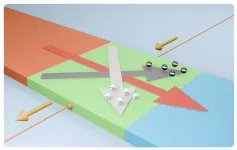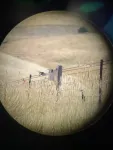(Press-News.org)
Cooling systems are an integral part of many modern technologies, as heat tends to wear down materials and decrease performance in several ways. In many cases, however, cooling can be an inconvenient and energy-intensive process. Accordingly, scientists have been seeking innovative and efficient methods to cool substances down.
Solid-state optical cooling is a prominent example that leverages a very unique phenomenon called anti-Stokes (AS) emission. Usually, when materials absorb photons from incoming light, their electrons transition into an “excited” state. Under ideal conditions, as electrons return to their original state, part of this excess energy is released as light, while the rest is converted into heat. In materials that undergo AS emission, electrons interact with crystal lattice vibrations called “phonons” in such a way that the photons emitted are of higher energy than those in the incident light. If AS emission efficiency is close to 100%, these materials could theoretically cool down, rather than heating up, upon exposure to light.
In a recent study published on August 29, 2024, in Volume 24, Issue 36 of Nano Letters, a team of researchers led by Professor Yasuhiro Yamada from the Graduate School of Science, Chiba University, Japan, delved deep into this phenomenon in a promising perovskite-based material structure. This team, which included Takeru Oki from the Graduate School of Science and Engineering, Chiba University, Dr. Kazunobu Kojima from the Graduate School of Engineering, Osaka University, and Dr. Yoshihiko Kanemitsu from the Institute for Chemical Research, Kyoto University, sought to shed light on the optical cooling phenomena in a special arrangement of perovskite quantum dots (extremely small CsPbBr3 crystals) embedded within a Cs4PbBr6 host crystal matrix (indicated as CsPbBr3/Cs4PbBr6 crystal).
“Efforts to achieve optical cooling in semiconductors have encountered several difficulties, primarily due to challenges in reaching nearly 100% emission efficiency, and true cooling has been elusive. Though quantum dots are promising for their high emission efficiency, they are notoriously unstable, and exposure to air and continued illumination degrade their emission efficiency. Thus, we focused on a stable structure known as ‘dots-in-crystals,’ which may overcome these limitations,” explains Yamada.
Using semiconducting quantum dots presents an unsolved problem. When light irradiates a semiconductor, it generates excitons—pairs of electrons and positively charged “holes.” When excitons recombine, they typically emit light. However, at high exciton densities, a process called Auger recombination becomes more prominent, by which energy is released as heat instead of light. In semiconductor quantum dots, irradiation with high-intensity light often leads to heating instead of cooling because of this process.
Thus, the researchers used time-resolved spectroscopy to determine the conditions under which Auger recombination occurred more frequently. These experiments showed that heating was unavoidable even at moderate light intensities, implying that experiments under low-intensity light were required to observe true optical cooling. Unfortunately, at low intensities, optical cooling becomes less effective. Under the best conditions, their sample demonstrated a theoretical cooling limit of approximately 10 K from room temperature.
Another focal point of the study was to make more reliable temperature measurements than in previously reported efforts. To this end, they developed a method to estimate the temperature of samples with high emission efficiency by analyzing the shape of their emission spectrum. True optical cooling was observed in multiple samples, and the researchers noted that a transition from cooling to heating occurred as the excitation light intensity was increased. “Previous reports of optical cooling in semiconductors lacked reliability, primarily due to flaws in temperature estimation. Our study, however, not only established a reliable method, but also defined the potential and limitations of optical cooling through time-resolved spectroscopy, marking a significant achievement in the field,” remarks Yamada.
This study paves the way for future research focused on minimizing Auger recombination to improve the cooling performance of dots-in-crystal arrangements. If optical cooling improves significantly to reach widespread practical use, it could become the foundation of several energy-saving technologies, contributing to global sustainability goals.
About Professor Yasuhiro Yamada from Graduate School of Science, Chiba University
Dr. Yasuhiro Yamada, a leading researcher at the Graduate School of Science, Chiba University, Japan, has made substantial contributions in the fields of materials science, semiconductor physics, and laser spectroscopy. His work focuses on the fundamental optical properties and carrier recombination dynamics of perovskite materials. Through his research, Prof. Yamada has enhanced the scientific community's understanding of exciton dynamics, electron-phonon interactions, and the optical functionalities of perovskite semiconductors. His work has paved the way for advancements in optoelectronics, with practical applications in energy and cooling technologies.
END
Thermoelectric materials, which convert heat into electricity, are valuable tools for capturing waste heat and turning it into usable electricity. These materials are especially useful in industries and vehicles where engines produce a lot of waste heat, improving energy efficiency by converting it into additional power. They also exhibit potential for portable power generation, in remote sensors and satellites where traditional power sources may be impractical.
Traditional thermoelectric devices, known as parallel thermoelectric devices, generate a voltage in the same direction as the heat ...
Recent research led by Kerstin Ozkan and published in PeerJ Life and Environment has uncovered the complex and contrasting effects of human-generated noise on Western Bluebird (Sialia mexicana) parental behavior, raising critical questions about how anthropogenic noise affects wildlife in both urban and non-urban settings. The study, titled “Divergent effects of short-term and continuous anthropogenic noise exposure on Western Bluebird parental care behavior,” explores how different types of noise exposure alter the bird's ...
Imagine gradually losing the ability to express yourself — not because you've forgotten the words, but because they simply won't come out. This is the reality for individuals living with primary progressive aphasia (PPA), a rare form of dementia that usually begins in middle age and increasingly impairs language abilities over time.
Researchers at the University of Chicago Medicine are working to illuminate the struggles of those living with this condition and pioneer accessible treatment models. They recently published new studies that measure PPA’s significant impact ...
Let’s say it’s a home game for the Golden State Warriors and Steph Curry shows he’s still got it, sinking back-to-back three-pointers minutes into the first quarter. The fans at Chase Center take notice, and so do the betting markets, where the odds move in the Warriors’ favor.
Yet it’s a long game. The away team comes back, and with just 10 seconds to go, the Warriors are down by two and have just missed a shot. A victory is unlikely, and the betting odds should have shifted to reflect that near-certainty. ...
CHICAGO – In patients with long COVID, lower pulmonary gas exchange may be associated with impaired cognitive function, according to a study being presented next week at the annual meeting of the Radiological Society of North America (RSNA).
According to the National Center for Health Statistics, approximately 17.6% of adults in the U.S. have experienced a post-COVID condition commonly referred to as long COVID. People with long COVID may exhibit a wide variety of symptoms, including difficulty concentrating (“brain fog”), change in sense of smell or taste, fatigue, joint or muscle pain, dyspnea (shortness of breath), digestive ...
CHICAGO – A new study of high school football players found that concussions affect an often-overlooked but important brain signal. The findings are being presented next week at the annual meeting of the Radiological Society of North America (RSNA).
Reports have emerged in recent years warning about the potential harms of youth contact sports on developing brains. Contact sports, including high school football, carry a risk of concussion. Symptoms of concussion commonly include cognitive disturbances, such as difficulty with balancing, ...
Laboratory experiments with cancer cells reveal two ways in which tumors evade drugs designed to starve and kill them, a new study shows.
While chemotherapies successfully treat cancers and extend patients’ lives, they are known not to work for everyone for long, as cancer cells rewire the process by which they convert fuel into energy (metabolism) to outmaneuver the drugs’ effects. Many of these drugs are so-called antimetabolics, disrupting cell processes needed for tumor growth and survival.
Three such drugs used in the study — raltitrexed, N-(phosphonacetyl)-l-aspartate (PALA), and brequinar ...
Climate change is the single biggest threat to the global environment and socio-economic development – demanding an urgent transformation of the United Nations’ Sustainable Development Goals (SDGs), according to a new study.
The UN SDGs were created to end poverty, build social-economic-health protection and enhance education and job opportunities, while tackling climate change and providing environmental protection.
Following last week’s COP29 environmental summit in Baku, University of Birmingham experts say that, as climate action is linked to sustainable development, systematic integration of climate resilience into every ...
UNDER STRICT EMBARGO UNTIL 10.00AM (UK TIME) ON 26 NOVEMBER 2024
New study reveals genetic drivers of early onset type 2 diabetes in South Asians
Peer reviewed | Observational study | People
A genetic predisposition to having lower insulin production and less healthy fat distribution are major causes of early-onset type 2 diabetes in British Asian people. According to new research from Queen Mary University of London, these genetic factors also lead to quicker development of health complications, earlier need for insulin treatment, and a weaker response ...
RICHLAND, Wash. —Tip the first tile in a line of dominoes and you’ll set off a chain reaction, one tile falling after another. Cross a tipping point in the climate system and, similarly, you might spark a cascading set of consequences like hastened warming, rising sea levels and increasingly extreme weather.
It turns out there’s more to weigh than catastrophic environmental change as tipping points draw near, though. Another point to consider, a new study reveals, is the cost of undoing the damage.
The cost of reversing the effects of climate change—restoring melted polar sea ice, for ...



